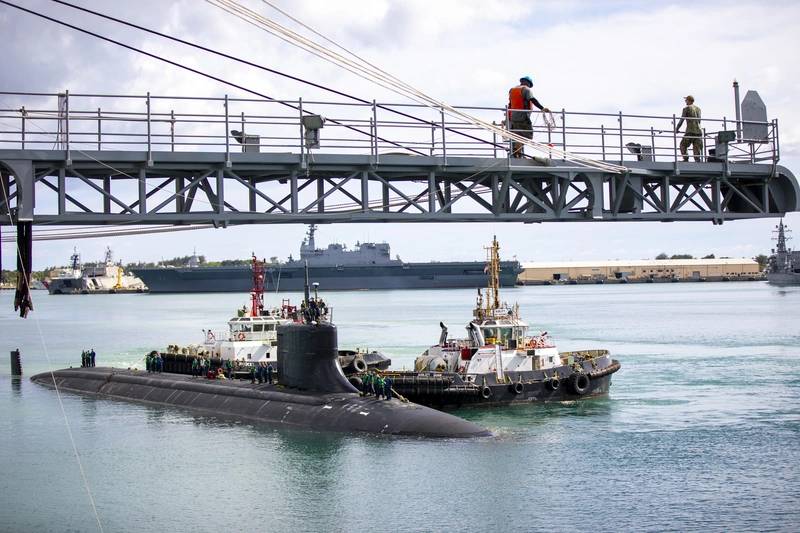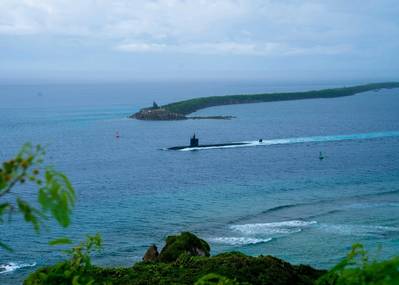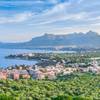Strategically Located, Guam's Defense Posture is Growing
With the rise of China and her global ambitions, the military importance of Guam in the Indo-Pacific theater has become apparent. The force levels on the island had drawn down from a peak of about 26,000 at the height of the Vietnam War to a tenth of that—just 2,500 people in the early 2000s. Today, that's changing. Guam's defense posture is growing.
Guam's proximity to major population centers in East Asia underscores its strategic importance. The island is just 1,400 miles from Tokyo, Manilla or Port Moresby.
All of the armed services have a presence on Guam. The Coast Guard has upgraded its presence with the establishment of Forces Micronesia/Sector Guam, and now has four fast response cutters and an ocean-going buoy tender homeported there to support missions in Oceania. The Army established a missile defense capability to protect the island following threats by Kim Jong-un. The THAAD battery is expanding to include more sensors, interceptors and command and control capability to provide 360-degree protection for the island. Anderson Air Force Base remains one of the largest military airfields in the theater and is ready to support surge operations for bombers, logistics aircraft and fighters.
While the Navy's Ship Repair Facility at Guam has diminished since the end of the Cold War, the Naval Base at Apra Harbor still provides much needed logistics support for transiting ships. And today a squadron of nuclear-powered attack submarines are based at Guam, supported by two submarine tenders that provide a full range of intermediate maintenance and repair.
The most dramatic change is taking place where the Marine Corps is building its first new base -- Marine Corps Base Camp Blaz (MCBCB) --in 70 years. When complete, 5,000 Marines currently forward deployed to Okinawa will be relocated to Guam. In addition to those Marines who will be garrisoned there, military forces throughout the Indo-PACOM area of responsibility will take advantage of the world-class training facilities being built there.
MCBCB's Skaggs Urban Training Complex will feature a "military operations in urban terrain" (MOUT) training facility. Repurposing 130 buildings that used to be a family housing area for Anderson Air Force Base, the "MOUT Town" can replicate any kind of urban training environment, complete with stores, churches, schools and even embassies. The training will be recorded and then played back for the participants to evaluate how well they performed in different scenarios.
"We'll have a live-fire range, a grenade range, a breacher course and a combat-vehicle operators training course," said Lt. Col Christopher Driscoll, the chief of staff for MCBCB. "With the MOUT facility, as well as the surrounding to 2,000 acres, we will be able work a regiment through here with within a fully secure area." The Seawolf-class fast-attack submarine USS Seawolf (SSN 21) sails into Apra Harbor, Naval Base Guam, Aug 25. Seawolf is a nuclear powered fast-attack submarine and is the lead ship of its class. (U.S. Navy photo by Mass Communication Specialist 2nd Class Joshua M. Tolbert)
The Seawolf-class fast-attack submarine USS Seawolf (SSN 21) sails into Apra Harbor, Naval Base Guam, Aug 25. Seawolf is a nuclear powered fast-attack submarine and is the lead ship of its class. (U.S. Navy photo by Mass Communication Specialist 2nd Class Joshua M. Tolbert)
The submarine force recognizes the critical location of Guam as a base of operations. "It's a strategic forward location; it's a tremendous logistics hub; and it's close to our allies and partners in the area," Capt. Carl Trask, commander of Submarine Squadron 15.
The submarine facilities at Polaris Point are also being upgraded to handle the new Virginia-class submarines. "We're going to be building a new pier, maintenance facilities and training center to support the Virginia class boats," said Trask.
Unlike other submarine homeports that have shipyards or intermediate maintenance activities, Guam's submarines are supported by two submarine tenders, which are also the last two tenders in the U.S.
As the U.S. Navy has pivoted to the Indo-Pacific and increased the number of submarines based here and deployed in theater, the workload warranted having another tender in Guam to get the mission done.
"We have two so they can be expeditionary," said Trask. "USS Frank Cable is in Vallejo, California, undergoing a normal drydocking period for maintenance; while USS Emory S. Land is here supporting the maintenance on my submarines."
The tenders have repair and maintenance technicians from every specialty in the Navy. "We perform the expeditionary rearm and reload mission to provide whatever a submarine might need, and in many cases, what a surface ship might need anywhere in the theater," said Emory S. Land Commanding Officer Capt. Brent Spillner. "We can fix just about everything on a submarine, from propulsion plant and non-nuclear work to the mechanical end of combat systems. The combat systems electronics work is usually handled by contractors, but we're standing by to support that effort, too, as required."
Despite being a relatively small island, it serves as a central point for defense related activities across a vast area, including the Commonwealth of Northern Marianas Islands (CNMI) to the north, and the three "compact of free association" (COFA) countries in Micronesia: Republic of Paula, Federated States of Micronesia and Republic of Marshall Islands. Like Guam, CNMI is sovereign U.S. territory.
"We do quite a bit of training here with various partners throughout the region. It's not nearly as far as going to Hawaii, which means more time training and less time in the transit," said Rear Adm. Benjamin Nicholson, who has serves as Senior Military Official for U.S. Indo-Pacific Command representing Guam, Commonwealth of the Northern Mariana Islands (CNMI), Federated States of Micronesia (FSM), and Republic of Palau; Commander, U.S. Naval Forces, Marianas; Commander, Task Force West and Commander, Joint Region Marianas.
There are significant training opportunities in CNMI. The Mariana Islands Range Complex (MIRC) encompasses 501,873 square nautical miles of open ocean and littorals and 64 nautical miles of land to provide multi-domain warfighting training.
More than half of the island of Tinian in the in the CNMI is a military use area for training. Another island, uninhabited Farallon de Medinilla, is used for live-fire exercises and naval gunfire support.
During recent regional training exercises, the U.S. demonstrated the ability to surge forces to the COFA nations including Army live-fire Patriot surface-to-air shots from Palau; Marines Corps HIMARS (High Mobility Artillery Rocket System) firings from one of the islands in Palau; Navy Seabees renovating medical facilities; and Air Force F-35s, F-22s and A-10s flying from the airfield at Koror.
"These exercises showed our ability to take forces that were staged here and press them out to other locations, setup, and then be able to operate from there very quickly," Nicholson said.
"Altogether," Nicholson said, "these activities demonstrate America's resolve to protect sovereign US and COFA territory, ensure security and stability in the region, and assure allies and partners that the U.S. will defend them." The Seawolf-class fast-attack submarine USS Seawolf (SSN 21) sails into Apra Harbor, Naval Base Guam, Aug 25, 2022. (U.S. Navy photo by Mass Communication Specialist Seaman Darek Leary)
The Seawolf-class fast-attack submarine USS Seawolf (SSN 21) sails into Apra Harbor, Naval Base Guam, Aug 25, 2022. (U.S. Navy photo by Mass Communication Specialist Seaman Darek Leary)













